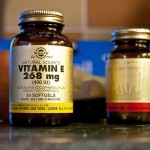 Vitamin E is the main lipid soluble antioxidant in humans and protects plasma membranes from peroxidation. Structurally, vitamin E is a group of eight closely related isomers that possess the same biological activity as α-tocopherol. The biochemistry of vitamin E is complex because eight stereoisomers of each structural isomer exist (here). The main biologically active form of vitamin E, D-α-tocopherol, possesses a dextrally (right) orientated methyl group on all its chiral carbons, and is therefore also called RRR-α-tocopherol. This D-α-tocopherol version of vitamin E is the natural form produced in plants and a significant contributor to total vitamin E intake.However, vitamin E can also be synthesised in the laboratory, but the chemical synthesis of vitamin E is less precise than that in plants. This imprecision results in half of the chiral carbons possessing sinistrally (left) orientated methyl groups and half possessing dextrally oriented methyl groups. Synthetic vitamin E is therefore called DL-α-tocopherol or all-rac-α-tocopherol.
Vitamin E is the main lipid soluble antioxidant in humans and protects plasma membranes from peroxidation. Structurally, vitamin E is a group of eight closely related isomers that possess the same biological activity as α-tocopherol. The biochemistry of vitamin E is complex because eight stereoisomers of each structural isomer exist (here). The main biologically active form of vitamin E, D-α-tocopherol, possesses a dextrally (right) orientated methyl group on all its chiral carbons, and is therefore also called RRR-α-tocopherol. This D-α-tocopherol version of vitamin E is the natural form produced in plants and a significant contributor to total vitamin E intake.However, vitamin E can also be synthesised in the laboratory, but the chemical synthesis of vitamin E is less precise than that in plants. This imprecision results in half of the chiral carbons possessing sinistrally (left) orientated methyl groups and half possessing dextrally oriented methyl groups. Synthetic vitamin E is therefore called DL-α-tocopherol or all-rac-α-tocopherol.
Because stereoisomers of α-tocopherol possessing sinistrally oriented methyl groups are not recognised by human metabolising proteins, the DL-α-tocopherol synthetically produced in laboratories has a lower biopotency than natural D-α-tocopherol. One mg of D-α-tocopherol has a relative biopotency of 1.36 IU, whereas one mg of DL-α-tocopherol has a relative biopotency of 1.0 IU. This has lead some to suggest that the D-α-tocopherol version of the vitamin is the prefered version for supplementation. However, at high doses, both forms are able to adequately raise plasma levels to supraphysiological values. For example, in a study published in the American Journal of Clinical Nutrition1, researchers fed a group of healthy volunteers 400 IU of vitamin E twice a day for 28 days. Supplements consisted of either DL-α-tocopheryl acetate or D-α-tocopheryl acetate. During supplementation levels of α-tocopherol rose in both groups, with no significant differences between the DL-α-tocopherol or D-α-tocopherol groups.
Therefore at high intakes both D-α-tocopherol and DL-α-tocopherol can increase plasma levels to a similar extent. However, at lower concentrations the more biopotent D-α-tocopherol may be superior at improving vitamin E status. Cessation of supplements caused plasma α-tocopherol concentrations to rapidly decline after one day, with values returning to baseline by day eight. However, although plasma levels declined rapidly, vitamin E levels in other tissues such as adipose tissue may remain elevated for some weeks following supplementation. Both DL-α-tocopherol and D-α-tocopherol have been reported to cause plasma concentrations of γ-tocopherol to fall significantly, and this study was no exception. In fact, γ-tocopherol plasma levels fell to around half their original values with the α-tocopherol supplements. This change was likely the result of the the preferential affinity of the hepatic tocopherol transfer protein (TTP) for α-tocopherol. High intakes of α-tocopherol inhibit packaging of γ-tocopherol into lipoproteins and as a result, plasma levels fall.
